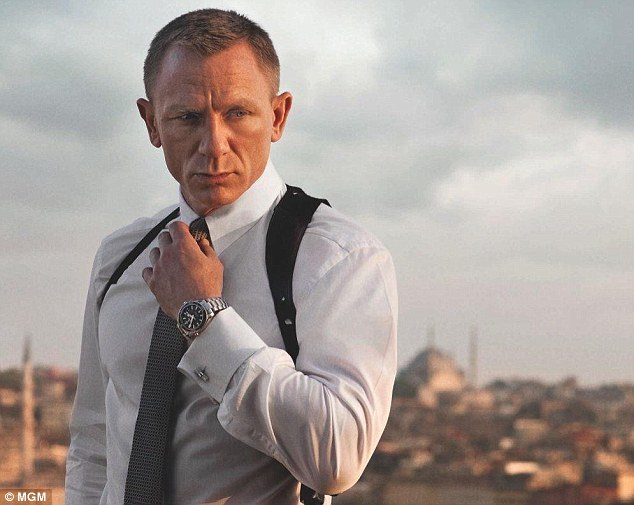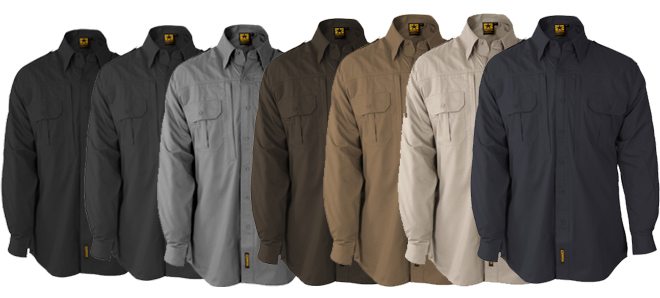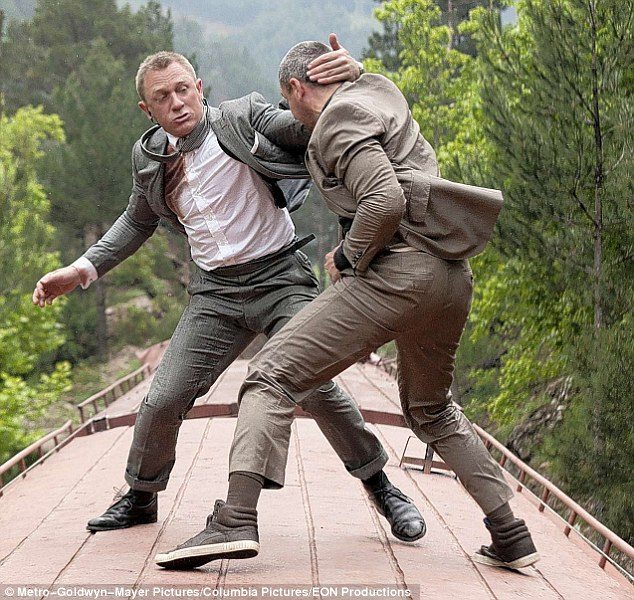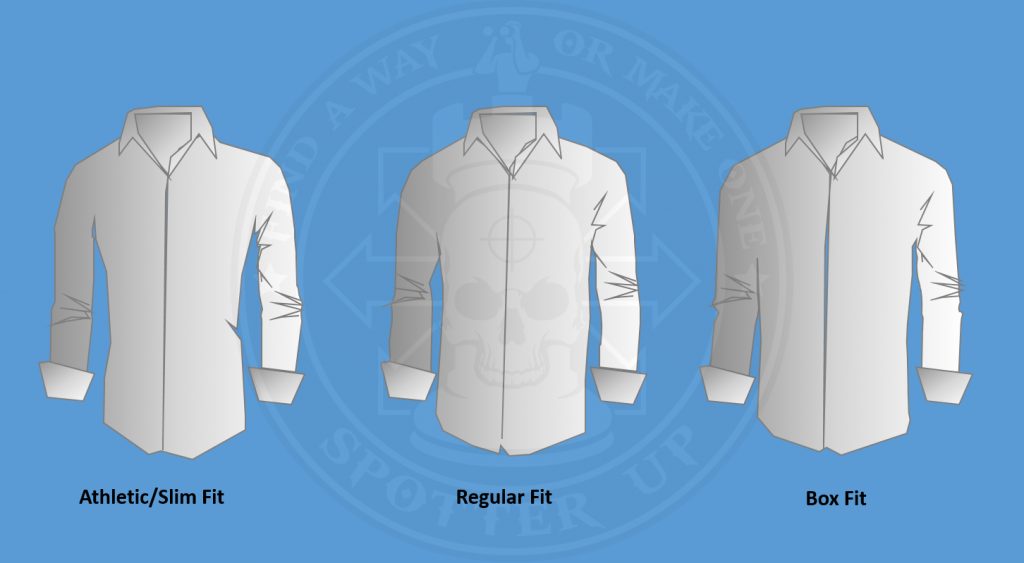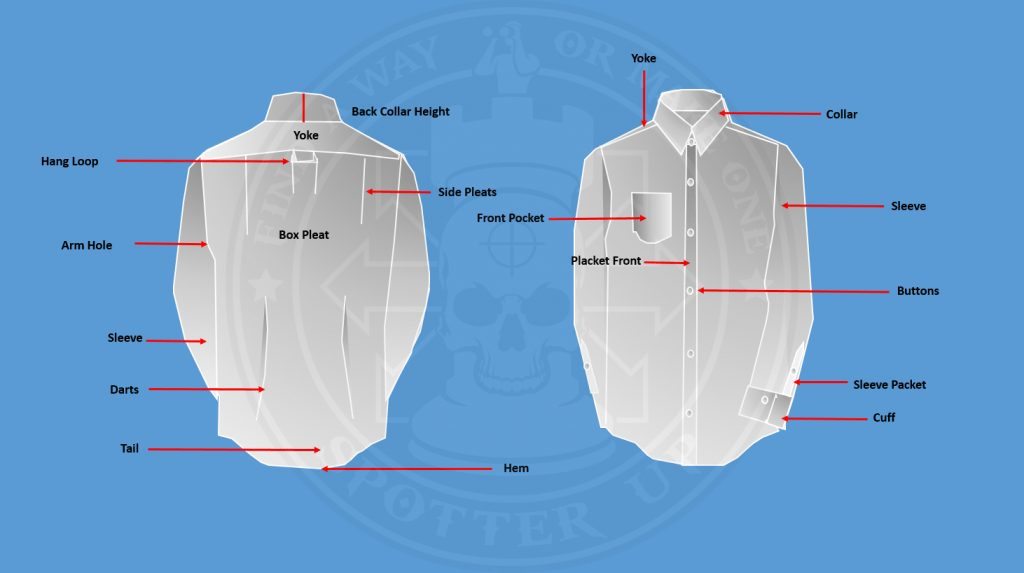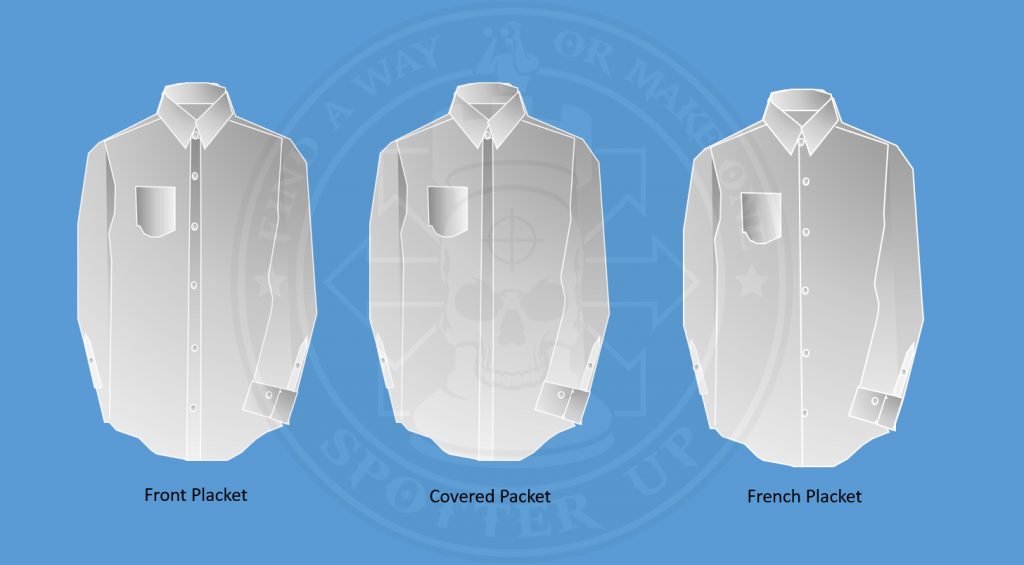Let’s talk about dress shirts and tactical dress shirts.
What is a dress shirt? A dress shirt, is a garment with a collar and a full-length opening at the front and a button down closure. It typically has long sleeves and can be worn with a necktie. It is worn for formal or semi-formal occasions.
What is a tactical dress shirt (TDS) ? A tactical dress shirt is a combination of a common dress shirt and a uniform shirt typically worn by law enforcement or armed forces personnel. While most dress shirts are constructed of cotton a TDS is constructed of sturdier materials intended to help it resist fading, wrinkling, tearing and shrinkage.
General features of a TDS are mitered and fused reinforced pocket flaps, an easy button down closure on the placket and pencil/pen compartments. The collar and cuff are usually fused and the shirt itself is made of a light-weight polyester material. A TDS has more room in the shoulders, chest and arms for the active and athletic individual. It may or may not taper at the waist but is generally constructed to be less billowy at the waist and less boxy than a common dress shirt, while allowing for a full range of motion.
The biggest mistake that people make is to purchase a shirt that doesn’t fit. The first thing you need to do is get yourself measured. Find out the measurements of your collar, neck and chest. Most of what you find at big box stores are made for the masses, rather than a man with specific wardrobe needs such as our man James Bond, but you don’t have to spend a lot of money to get a nice look. My goal in this article is to describe the different features of a shirt so our readers can make the best purchase for their money; particularly if they are in a protective services role that demands they wear a business suit. Those that can afford custom-made clothing should still take note about some of my points. Your shirt should not be so tight or loose that it restricts your ability to be effective in any environment you’re in.
The picture below shows a man wearing an oversized box cut shirt. Too much billowy material can hinder a shooter from retrieving his weapon.
To start off let’s look at the picture posted below. I’m uncertain why the actor Daniel Craig’s suit pants are cuffed or why the villain he is fighting is wearing high tops. I’m unsure if this is simply for purposes of style or so the stunts can be performed with less difficulty. My goal is not to be a movie geek or fashionista but it is to simply illustrate that energetic activity by people demands they wear properly fitted clothing. There are many excellent websites that describe, fashion, tailoring and so forth. I am only concerned with clothing that can make a person more “tactically” sound.
Buying well-made, affordable, and fitted clothing is easier to do today than it was even just a year ago due to the growing custom retail shops on the internet. If you don’t shop online then do consider buying at clothing outlets such as Nordstrom Rack, Burlington Coat Factory and major brand outlets which give you many affordable options to pick from. If you want to look presentable in your role as a bodyguard, protective agent or a plain clothes officer, take some time to put your wardrobe together the right way.
Knowing this information, how do you find the best dress shirt for your suit, that shares some of the same features offered in a TDS? Before we list all of those features let’s illustrate the different kinds of shirt shapes and how they fit.
FIT
Shirts come in Slim Fit, Regular Fit and Box Fit. Sometimes they are called Athletic Fit, Normal Fit or Wide Fit. Knowing the reasoning behind the labels will help you make better choices when selecting shirts for your wardrobe. Look at the labelling on the package. Some brands place an illustration on the package informing shoppers of the cut of the shirt inside the package. It isn’t enough to purchase a shirt solely based off the color of the material or the dimensions of the neck and sleeve length listed on the label.
SLIM FIT: People that exercise or those with body types larger than the average person tend to have fuller chests, forearms, shoulders and arms. Slim fitting shirts are sought out by people who want to show off their physique however this cut of shirt tends to be body-hugging and doesn’t provide the upper body a full range of motion. Slim fitting shirts is also ideal for someone with a lean build. Slim fitting shirts have stitched material called side darts, back darts, and center-folds to pull the shirt in to give it a cleaner look.
Actor Daniel Craig wearing a high-quality slim fitting shirt over an athletic build. Notice there isn’t any overflowing fabric over his waist.
Unless you get the shirt tailored to be less form-fitting, or purchase it in a stretchy synthetic material I do not recommend wearing a slim-fitting shirt with an athletic build. If it fits well, without hindering movement, then make the purchase. Other options are to purchase a slim fit but go up one size to give yourself a bit more room. Don’t let style hinder your ability to do your job well. What looks good on you in the mirror might not be practical on the street as a defender, or as an attacker. There are many companies that make this kind of slim cut shirt in a wrinkle-free material that stretches.
BOX FIT: This kind of shirt is made for someone with a wide body. It is generally made for someone who is chubby or broad. The extra material is ideal for a wide-waisted or broad chested person. A shirt with extra material on the sides won’t fully tuck into your trousers and you’ll be left with material billowing on the sides of your waist; this is not ideal when using a gun and holster. The weapon can be enveloped by the excess material.
REGULAR FIT: This kind of shirt is the best to purchase. Minor alterations by a tailor will make it fit nicely on your body.
ANATOMY OF A SHIRT
Let’s look at the different parts of a shirt.
COLLARS: Look for collars with a reasonable collar height for your neck. If you have a short neck, or a tall collar, a stiff collar can irritate the skin under your chin and jaw. Soft collared and stiff collared shirts come with buttons and without buttons on them. It is much easier to take a tie off of a shirt without buttons on the shirt collar.
The back of the collar helps maintain the fit around your shoulders and neck. The back of the collar, called the collar band, should be tall enough to prevent your tie from poking out under your collar. Have your neck measured to make sure you know your neck size.
CUFFS: Cuffs should be visible even beneath a jacket. Cuffs should break right above the wrist bone and not be so overly long that you have to constantly pull them up.
CHEST POCKETS: I personally do not prefer wearing dress shirts with chest pockets. I believe pockets on shirts are more suited for sport shirts. Dress shirts should not have pockets with flaps. Flaps are good for TDS because you can insert things such as shotgun shells, a small knife or map. If you decide to purchase a shirt with a chest pocket then buy a quality pen that will not leak ink onto your shirt.
DARTS: A dart is created by folding a material onto itself; doing this creates a permanent fold. Darts help to reduce billowy material because of excess fabric.
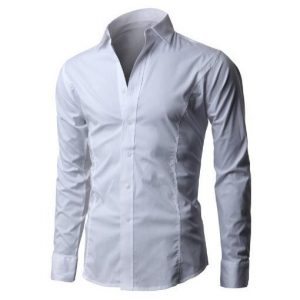
HEM: The hem is the bottom of the shirt. Shirts with a tail hem are designed to be tucked into your pants. Shirts with a square hem are designed to be untucked. If you are buying a shirt, check to see if it has a tail hem so that it can be fully tucked into trousers. This makes sense when using an in the waistband holster (IWB). It is also good for an outside the waistband (OWB), with or without a jacket for concealment.
SHIRT PLACKET: The placket is the material that runs the length of the shirt. A placket is an opening in the upper part of trousers or skirts, or at the neck or sleeve of a garment. Sometimes it is there as a design element but it is there to allow clothing to be put on or removed easily. Choose a seamless or front placket. I do not recommend a shirt with a covered placket that hides your buttons. If you need to take your shirt off for some reason, it will take more time to do this.
PLEETS: A pleet is a fold of definite, even width made by doubling cloth or the like upon itself and pressing or stitching it in place. It allows the shirt to give way when your body stretches or bends. Pleets are usually found on store-bought shirts, rather than custom-made shirts, to ensure they fit anyone.
SLEEVES: Sleeves should not be too tight or too loose. Sleeves that are too loose end up making the cuff droop below the jacket sleeve. Sleeves that are too tight will cause the cuff to disappear up your jacket. Your shirt tail will also untuck from your pants because a tight sleeve will tug on it. It is best to have a loose sleeve and a tighter cuff to prevent this from occurring. Men with long arms should purchase shirts with two buttons. Men with shorter arms can purchase shirts with two buttons on each shirt cuff because it can give the illusion of longer arms. Never buy short-sleeved shirts for dress wear. It looks unprofessional.
SIDE GUSSET: A hem gusset is created when triangular pieces of fabric bind the front and back of the shirttails together. It’s dual function is to reinforce the junction of the shirttails and to pin excess material together.
TAIL: The tail of your shirt should fully cover, and not half-way cover, your seat. If it does not cover your seat it is likely to pull out of your pants when you are active.
YOKE: The yoke conceals the shoulder seams and adds to a better fit. It allows the shirt to fall over the shoulders for a better fit and it strengthens the shirt. It’s primary purpose is to provide support for looser parts of the garment.
MATERIALS
I’m not going to cover materials in this article. There are many benefits to natural materials such as cotton or linen, and man-made materials. Many brands offer blends and these are very ideal. I recommend finding a shirt that offers good breathability, durability and lots of movement. Have room for your arms to swing and chest to breathe. You should be able to wear it and breathe without effort.
Find what works for you.
How to Find the Best Athletic Tactical Dress Suit, Part 1, Pants —
How to Find the Best Athletic Tactical Dress Suit, Part 2, Socks
